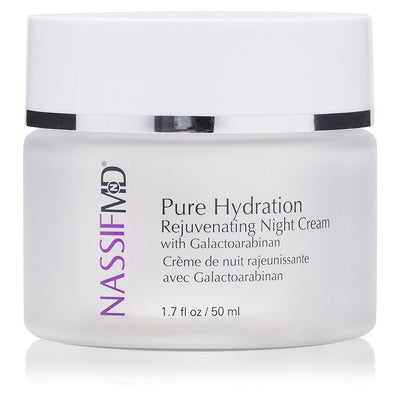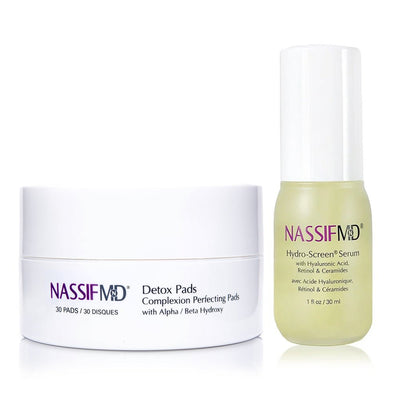How to Get Rid of Bags and Dark Circles Under Eyes
Do you have dark circles under your eyes, even after a good night’s rest? Well, you’re not alone. Bags under the eyes are a common dermatological and aesthetic concern of many people, especially women.
While lack of sleep certainly plays a role, there are many other factors to consider when undereye circles are dark and puffy. If you always look tired because of eye bags, today’s article will help to get to the root of your concern.
Keep reading to learn more about:
- What causes bags under the eyes?
- How to get rid of eye bags
- Eye cream vs. eye serum
- Must-have under-eye cream ingredients
What Causes Bags Under Eyes?
Dark undereye circles and bags are also called periorbital hyperpigmentation, a common dermatological condition with pigment changes that affect the epidermis and dermis. The appearance of tired, puffy eyes affects well-being and quality of life.
It’s helpful to understand the root causes of eye bags for successful treatment. However, dark circles and bags are often the result of more than one factor.
Some factors to consider are genetics, lifestyle, allergies, and aging.
Genetics
Dark circles under the eyes tend to run in families because of genetic similarities in cranial structure, hyperpigmentation, number of skin capillaries, the thinness of the skin under the eye, and other genetic pieces. Many of these genetic pieces appear across races.
Unfortunately, genetics is one factor in eye bags that we can’t change, but since many factors play a role, it’s possible to see improvements still.
Lifestyle
Lifestyle and daily habits play a role in the appearance of dark circles under the eyes. Some lifestyle aspects to consider include:
- Lack of sleep, especially chronic poor sleep
- Alcohol and tobacco use
- Stress
- Caffeine use
- Poor diet
Iron-deficiency anemia occurs when iron levels are low due to inadequate intake of iron-rich foods, issues with nutrient absorption, or iron loss through blood loss. Iron deficiency is common globally and causes fatigue, weakness, and impaired cognition. In addition, without enough iron, the blood can’t carry enough oxygen to cells, and the area under the eyes can appear darker.
Allergies
Allergies are another underlying cause of dark circles under the eyes. In this context, you’ll hear many call the circles “allergic shiners” because the under-eye area appears darker, often blue or purple, like a bruise.
Environmental allergies, including seasonal allergies and food allergies (dairy is a common one), may be the root cause. The allergies cause nasal and sinus congestion and inflammation. As your immune system tends to the allergy, it causes dilated blood vessels and more blood to the area, which appears as dark circles and puffiness.
Aging
Skin changes due to aging are another cause of bags and dark circles under the eyes. With age, the skin loses collagen and elastin, which leads to skin sagging, fine lines, and wrinkles. Exposure to toxins and lack of sun protection that accelerate aging can also affect the delicate skin under the eyes.
How to Get Rid of Eye Bags
Once you understand the possible factors contributing to your dark circles, you can address the areas within your control. While you can’t stop aging, for example, you can support and protect your skin in new ways to slow the process.
Next, we will cover lifestyle changes and topical solutions for bags and dark circles.
Get More Sleep
Sometimes we look tired because we are. Sleep is the most helpful place to start if you have dark circles under your eyes. Improving sleep will improve your appearance and all aspects of life and health.
If you have trouble sleeping, create a consistent, relaxing bedtime ritual that includes your skincare routine and other self-care practices. Turn off your phone, limit screen use after dark, and make your bedroom cool and dark.
Maintain a Healthy Diet
An anti-inflammatory and antioxidant-rich diet can do wonders for your skin from the inside out. Your skin health benefits from supporting gut health and providing your body with essential nutrients via nutrition. Learn more about the gut-skin connection and diet strategies for inside-out skincare here.
If eye puffiness and darkness is due to water retention, you can adjust your diet to help. One strategy is to reduce sodium intake by decreasing processed foods and focusing on fresh-whole foods that contain the full spectrum of mineral electrolytes to maintain and improve hydration.
Keep Skin Hydrated
Skin hydration is vital for overall skin appearance and function. Internal hydration from water, water-containing foods, and electrolytes is foundational. In addition, you can hydrate your skin by choosing hydrating skincare products that pull water into the skin, prevent water loss, and moisturize. Learn more about skin hydration here.
Topical Eye Creams
In addition to lifestyle strategies, topical eye serums and creams are common treatment approaches for dark circles and bags under the eyes.
Because the skin under the eyes is more fragile than the rest of the face and signs of aging tend to appear there first, your eyes may need some extra attention. Eye serums and creams with targeted antioxidants and other effective, gentle ingredients support a more even skin tone, texture, and appearance.
Eye Cream Vs. Eye Serum: What Is the Difference?
Serums are light skincare products with concentrated ingredients for specific skin issues, such as under-eye health. Apply serums after cleansing the skin for easy absorption. You can also layer multiple serums as desired.
Learn about face serums and why you need them in this article.
Eye creams are applied over serums to lock in moisture and active ingredients in the serum. The primary purpose of the cream is to moisturize, but they also contain active ingredients to support under-eye health.
Best Under Eye Cream Ingredients for Dark Circles & Puffiness
Not all serums and creams are created equal. You want to choose quality products with active ingredients targeted for dark circles, puffiness, sagginess, and dryness. You may need to use separate products on the delicate under-eye area or layer them with products you use on the entire face. Some of the best ingredients for dark circles are vitamin C, hyaluronic acid, squalene, and peptides, including Argireline.
Vitamin C
Vitamin C is a powerful antioxidant essential for skin health. It fights free radical damage and supports skin structure by promoting collagen production. Concentrated vitamin C used topically helps with hyperpigmentation by lightning and evening the skin tone.
Hyaluronic Acid & Squalane
Hyaluronic acid and squalene are other skincare ingredients that support eye bags.
Hyaluronic acid is a hydrating, skin-plumping ingredient. It is a humectant and binds to water, locking moisture into the skin. Hyaluronic acid has many other benefits, including reducing the appearance of fine lines and supporting the skin barrier. When your skin sags under your eyes, hyaluronic acid is a must-have!
Squalene is a natural molecule found in sebum, the oil produced by the skin. When applied topically, it’s highly compatible with the skin and helps reduce inflammation and prevent moisture loss for more supple skin.
Argireline
Argireline is an advanced skin peptide called acetyl hexapeptide-8. Known as “Botox in a bottle,” it reduces the appearance of expression lines and wrinkles and promotes more radiant skin.
Learn all about peptides and their application to skincare products in this article.
NassifMD® Eye Serum and Cream
If you want an eye serum and cream to add to your skincare routine, look no further. NassifMD® products are designed with an understanding of the critical skincare ingredients to support the delicate area around the eyes and improve dark circles, hydration, and sagging.
NassifMD® Age Defying Eye Renewal Serum with Dual Action Peptides is a lightweight formula that deeply penetrates into the skin under and around the eyes. It contains Argireline, other peptides (called acetyl tetrapeptide-5 complex), hyaluronic acid, and aloe. The result is a soothing serum that hydrates, moisturizes, and protects the skin to reduce puffiness, brighten dark circles, and minimize wrinkles.
NassifMD® Peri-Orbital Eye Complex is an effective under-eye cream containing a synergy of active ingredients including hyaluronic acid, vitamin C, and squalene to tighten, firm, and revitalize the skin for a younger, smoother appearance and tone.
While dark circles are common, there are many ways you can address them with lifestyle habits and quality skincare products for the under-eye area. The first step is understanding the factors contributing to your dark circles, whether aging, allergies, or diet. Then, you can build a plan to address those factors with a holistic approach that includes vitamin C, squalene, peptides, and other proven ingredients.
References
- Sarkar, R., & Das, A. (2018). Periorbital Hyperpigmentation: What Lies Beneath?.Indian dermatology online journal, 9(4), 229–230.
- Samaan, C. B., & Cartee, T. V. (2023). Treatment of Periorbital Vascularity, Erythema, and Hyperpigmentation.Clinics in plastic surgery, 50(3), 399–409.
- Mac-Mary, S., Zornoza Solinis, I., Predine, O., Sainthillier, J. M., Sladen, C., Bell, M., & O'Mahony, M. (2019). Identification Of Three Key Factors Contributing To The Aetiology Of Dark Circles By Clinical And Instrumental Assessments Of The Infraorbital Region.Clinical, cosmetic and investigational dermatology, 12, 919–929.
- Sheth, P. B., Shah, H. A., & Dave, J. N. (2014). Periorbital hyperpigmentation: a study of its prevalence, common causative factors and its association with personal habits and other disorders.Indian journal of dermatology, 59(2), 151–157.
- Matsui, M. S., Schalka, S., Vanderover, G., Fthenakis, C. G., Christopher, J., Bombarda, P. C., Bueno, J. R., Viscomi, B. L., & Bombarda Júnior, M. S. (2015). Physiological and lifestyle factors contributing to risk and severity of peri-orbital dark circles in the Brazilian population.Anais brasileiros de dermatologia, 90(4), 494–503.
- Jimenez, K., Kulnigg-Dabsch, S., & Gasche, C. (2015). Management of Iron Deficiency Anemia.Gastroenterology & hepatology, 11(4), 241–250.
- Michelle, L., Pouldar Foulad, D., Ekelem, C., Saedi, N., & Mesinkovska, N. A. (2021). Treatments of Periorbital Hyperpigmentation: A Systematic Review.Dermatologic surgery : official publication for American Society for Dermatologic Surgery [et al.], 47(1), 70–74.
- Pullar, J. M., Carr, A. C., & Vissers, M. C. M. (2017). The Roles of Vitamin C in Skin Health.Nutrients, 9(8), 866.
- Paramasivan, K., & Mutturi, S. (2022). Recent advances in the microbial production of squalene.World journal of microbiology & biotechnology, 38(5), 91.
- Lim, S. H., Sun, Y., Thiruvallur Madanagopal, T., Rosa, V., & Kang, L. (2018). Enhanced Skin Permeation of Anti-wrinkle Peptides via Molecular Modification.Scientific reports, 8(1), 1596.























